Research Proposal: Assessment of Australia’s Tax Reforms Effect
VerifiedAdded on 2023/04/22
|27
|7202
|419
AI Summary
This research proposal aims to assess the effectiveness of Australia's corporate tax reforms on its economic growth, focusing on the impact of lowering corporate tax rates to attract foreign investors. The proposal identifies the problem of Australia's uncompetitive corporate tax rate and the potential negative impacts of tax reforms on its small economy. It seeks to determine the effectiveness of previous tax reforms, identify challenges in implementing new policies, and analyze the benefits of tax reforms in local and international trade. The research will employ an exploratory study with a qualitative approach, utilizing secondary data such as journals. The proposal includes a literature review discussing Australia's corporate tax rate, its current issues, the significance of lowering rates, competitive decline, international tax changes, and comparative tax rates, ultimately aiming to determine if lowering corporate tax rates is the best strategy for improving Australia's economic growth.
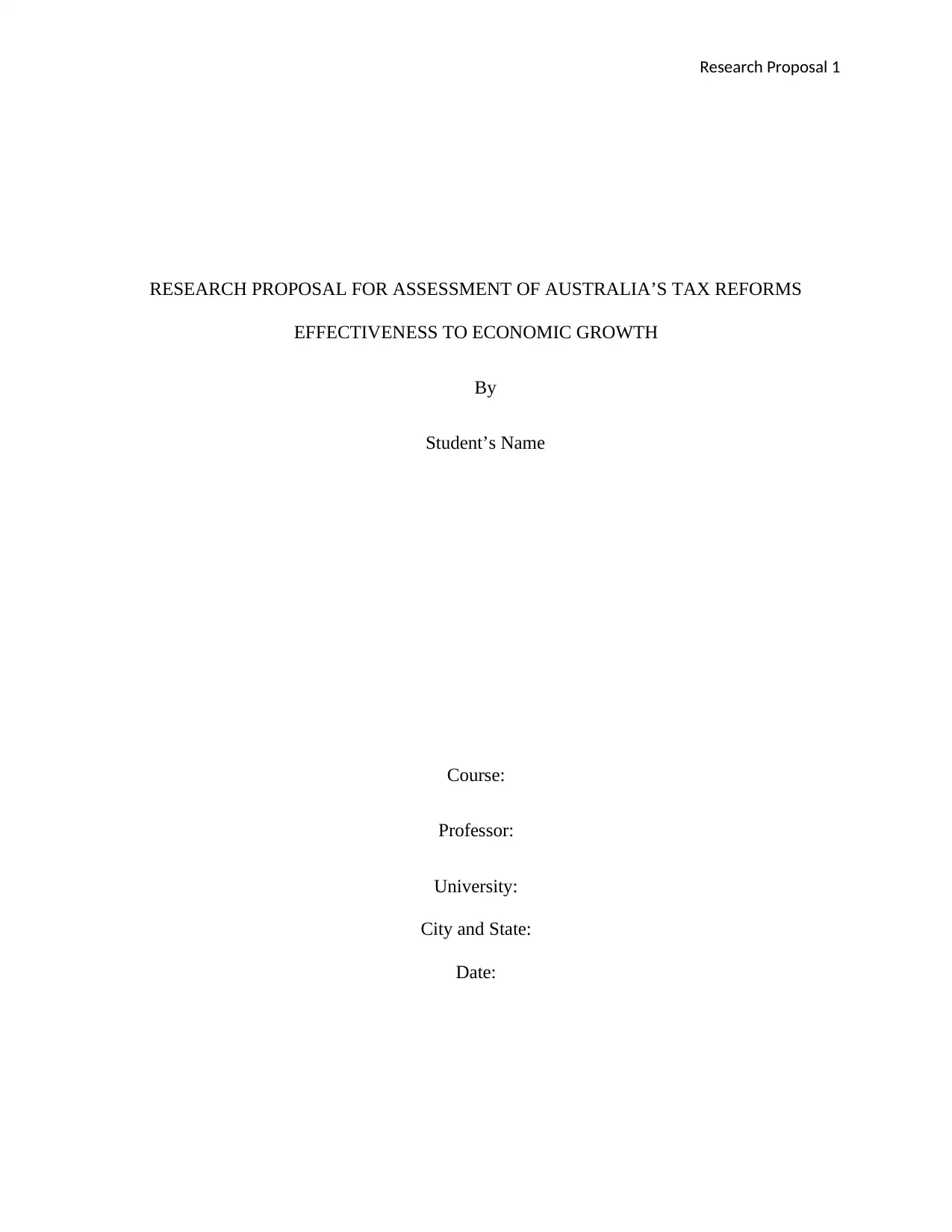
Research Proposal 1
RESEARCH PROPOSAL FOR ASSESSMENT OF AUSTRALIA’S TAX REFORMS
EFFECTIVENESS TO ECONOMIC GROWTH
By
Student’s Name
Course:
Professor:
University:
City and State:
Date:
RESEARCH PROPOSAL FOR ASSESSMENT OF AUSTRALIA’S TAX REFORMS
EFFECTIVENESS TO ECONOMIC GROWTH
By
Student’s Name
Course:
Professor:
University:
City and State:
Date:
Paraphrase This Document
Need a fresh take? Get an instant paraphrase of this document with our AI Paraphraser
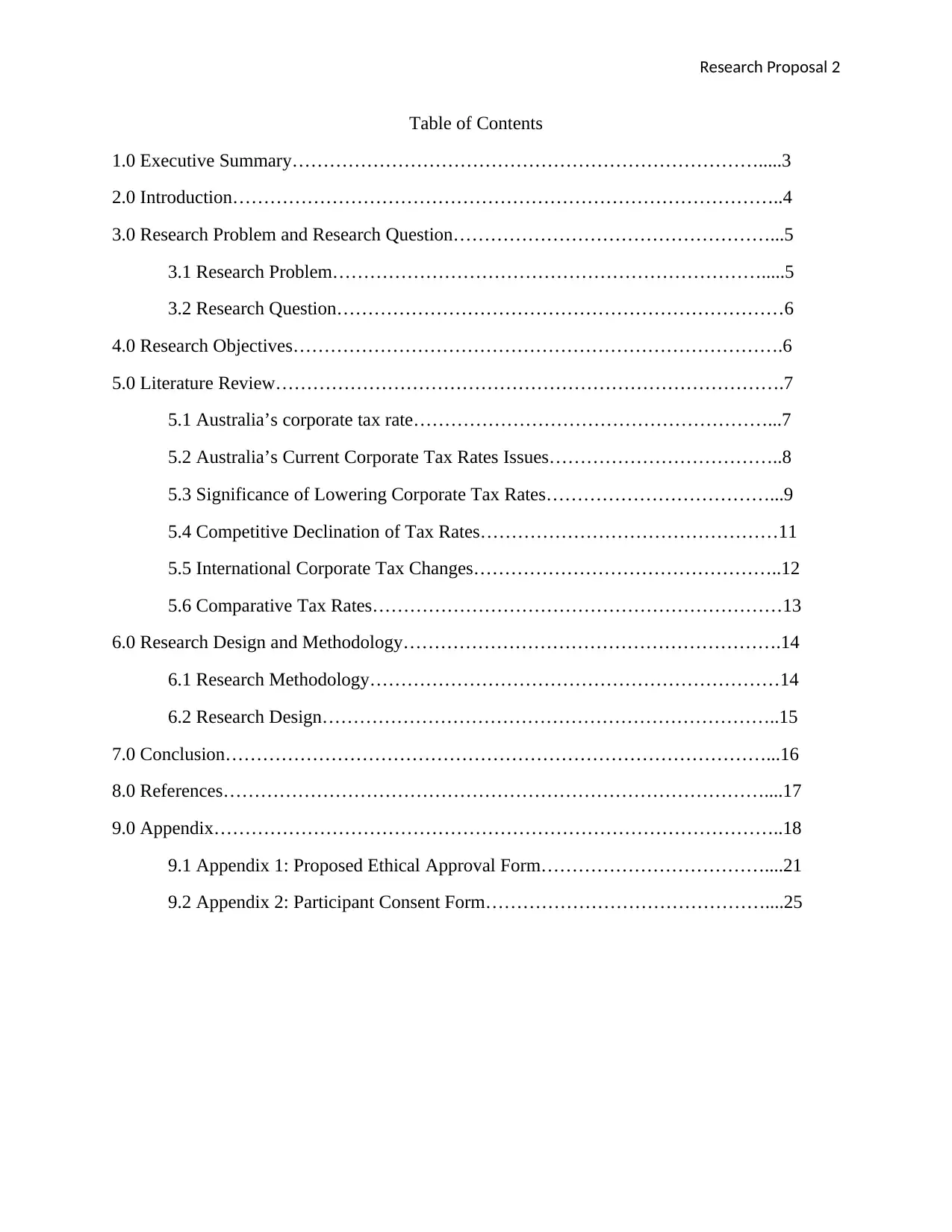
Research Proposal 2
Table of Contents
1.0 Executive Summary………………………………………………………………….....3
2.0 Introduction……………………………………………………………………………..4
3.0 Research Problem and Research Question……………………………………………...5
3.1 Research Problem…………………………………………………………….....5
3.2 Research Question………………………………………………………………6
4.0 Research Objectives…………………………………………………………………….6
5.0 Literature Review……………………………………………………………………….7
5.1 Australia’s corporate tax rate…………………………………………………...7
5.2 Australia’s Current Corporate Tax Rates Issues………………………………..8
5.3 Significance of Lowering Corporate Tax Rates………………………………...9
5.4 Competitive Declination of Tax Rates…………………………………………11
5.5 International Corporate Tax Changes…………………………………………..12
5.6 Comparative Tax Rates…………………………………………………………13
6.0 Research Design and Methodology…………………………………………………….14
6.1 Research Methodology…………………………………………………………14
6.2 Research Design………………………………………………………………..15
7.0 Conclusion……………………………………………………………………………...16
8.0 References……………………………………………………………………………....17
9.0 Appendix………………………………………………………………………………..18
9.1 Appendix 1: Proposed Ethical Approval Form………………………………....21
9.2 Appendix 2: Participant Consent Form………………………………………....25
Table of Contents
1.0 Executive Summary………………………………………………………………….....3
2.0 Introduction……………………………………………………………………………..4
3.0 Research Problem and Research Question……………………………………………...5
3.1 Research Problem…………………………………………………………….....5
3.2 Research Question………………………………………………………………6
4.0 Research Objectives…………………………………………………………………….6
5.0 Literature Review……………………………………………………………………….7
5.1 Australia’s corporate tax rate…………………………………………………...7
5.2 Australia’s Current Corporate Tax Rates Issues………………………………..8
5.3 Significance of Lowering Corporate Tax Rates………………………………...9
5.4 Competitive Declination of Tax Rates…………………………………………11
5.5 International Corporate Tax Changes…………………………………………..12
5.6 Comparative Tax Rates…………………………………………………………13
6.0 Research Design and Methodology…………………………………………………….14
6.1 Research Methodology…………………………………………………………14
6.2 Research Design………………………………………………………………..15
7.0 Conclusion……………………………………………………………………………...16
8.0 References……………………………………………………………………………....17
9.0 Appendix………………………………………………………………………………..18
9.1 Appendix 1: Proposed Ethical Approval Form………………………………....21
9.2 Appendix 2: Participant Consent Form………………………………………....25
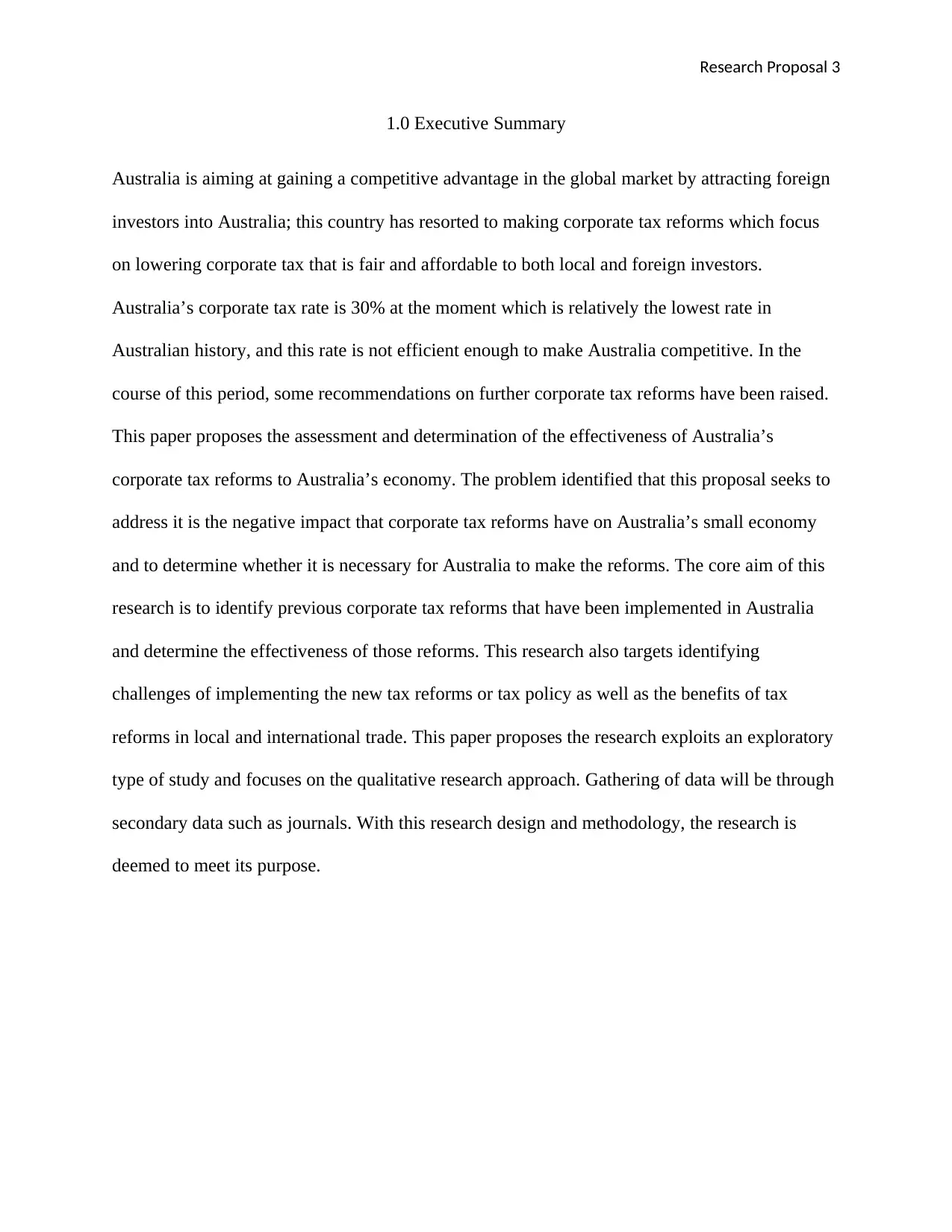
Research Proposal 3
1.0 Executive Summary
Australia is aiming at gaining a competitive advantage in the global market by attracting foreign
investors into Australia; this country has resorted to making corporate tax reforms which focus
on lowering corporate tax that is fair and affordable to both local and foreign investors.
Australia’s corporate tax rate is 30% at the moment which is relatively the lowest rate in
Australian history, and this rate is not efficient enough to make Australia competitive. In the
course of this period, some recommendations on further corporate tax reforms have been raised.
This paper proposes the assessment and determination of the effectiveness of Australia’s
corporate tax reforms to Australia’s economy. The problem identified that this proposal seeks to
address it is the negative impact that corporate tax reforms have on Australia’s small economy
and to determine whether it is necessary for Australia to make the reforms. The core aim of this
research is to identify previous corporate tax reforms that have been implemented in Australia
and determine the effectiveness of those reforms. This research also targets identifying
challenges of implementing the new tax reforms or tax policy as well as the benefits of tax
reforms in local and international trade. This paper proposes the research exploits an exploratory
type of study and focuses on the qualitative research approach. Gathering of data will be through
secondary data such as journals. With this research design and methodology, the research is
deemed to meet its purpose.
1.0 Executive Summary
Australia is aiming at gaining a competitive advantage in the global market by attracting foreign
investors into Australia; this country has resorted to making corporate tax reforms which focus
on lowering corporate tax that is fair and affordable to both local and foreign investors.
Australia’s corporate tax rate is 30% at the moment which is relatively the lowest rate in
Australian history, and this rate is not efficient enough to make Australia competitive. In the
course of this period, some recommendations on further corporate tax reforms have been raised.
This paper proposes the assessment and determination of the effectiveness of Australia’s
corporate tax reforms to Australia’s economy. The problem identified that this proposal seeks to
address it is the negative impact that corporate tax reforms have on Australia’s small economy
and to determine whether it is necessary for Australia to make the reforms. The core aim of this
research is to identify previous corporate tax reforms that have been implemented in Australia
and determine the effectiveness of those reforms. This research also targets identifying
challenges of implementing the new tax reforms or tax policy as well as the benefits of tax
reforms in local and international trade. This paper proposes the research exploits an exploratory
type of study and focuses on the qualitative research approach. Gathering of data will be through
secondary data such as journals. With this research design and methodology, the research is
deemed to meet its purpose.
⊘ This is a preview!⊘
Do you want full access?
Subscribe today to unlock all pages.

Trusted by 1+ million students worldwide
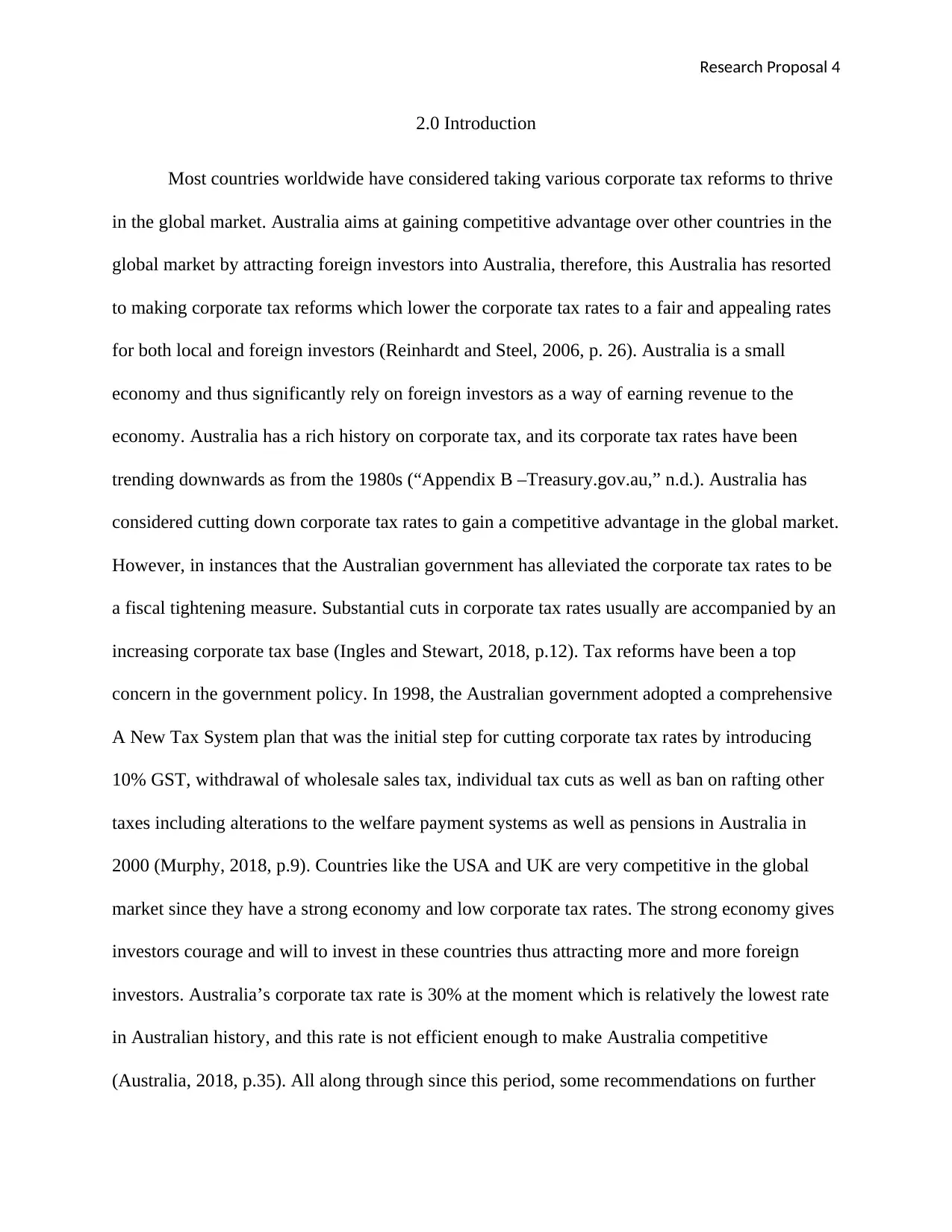
Research Proposal 4
2.0 Introduction
Most countries worldwide have considered taking various corporate tax reforms to thrive
in the global market. Australia aims at gaining competitive advantage over other countries in the
global market by attracting foreign investors into Australia, therefore, this Australia has resorted
to making corporate tax reforms which lower the corporate tax rates to a fair and appealing rates
for both local and foreign investors (Reinhardt and Steel, 2006, p. 26). Australia is a small
economy and thus significantly rely on foreign investors as a way of earning revenue to the
economy. Australia has a rich history on corporate tax, and its corporate tax rates have been
trending downwards as from the 1980s (“Appendix B –Treasury.gov.au,” n.d.). Australia has
considered cutting down corporate tax rates to gain a competitive advantage in the global market.
However, in instances that the Australian government has alleviated the corporate tax rates to be
a fiscal tightening measure. Substantial cuts in corporate tax rates usually are accompanied by an
increasing corporate tax base (Ingles and Stewart, 2018, p.12). Tax reforms have been a top
concern in the government policy. In 1998, the Australian government adopted a comprehensive
A New Tax System plan that was the initial step for cutting corporate tax rates by introducing
10% GST, withdrawal of wholesale sales tax, individual tax cuts as well as ban on rafting other
taxes including alterations to the welfare payment systems as well as pensions in Australia in
2000 (Murphy, 2018, p.9). Countries like the USA and UK are very competitive in the global
market since they have a strong economy and low corporate tax rates. The strong economy gives
investors courage and will to invest in these countries thus attracting more and more foreign
investors. Australia’s corporate tax rate is 30% at the moment which is relatively the lowest rate
in Australian history, and this rate is not efficient enough to make Australia competitive
(Australia, 2018, p.35). All along through since this period, some recommendations on further
2.0 Introduction
Most countries worldwide have considered taking various corporate tax reforms to thrive
in the global market. Australia aims at gaining competitive advantage over other countries in the
global market by attracting foreign investors into Australia, therefore, this Australia has resorted
to making corporate tax reforms which lower the corporate tax rates to a fair and appealing rates
for both local and foreign investors (Reinhardt and Steel, 2006, p. 26). Australia is a small
economy and thus significantly rely on foreign investors as a way of earning revenue to the
economy. Australia has a rich history on corporate tax, and its corporate tax rates have been
trending downwards as from the 1980s (“Appendix B –Treasury.gov.au,” n.d.). Australia has
considered cutting down corporate tax rates to gain a competitive advantage in the global market.
However, in instances that the Australian government has alleviated the corporate tax rates to be
a fiscal tightening measure. Substantial cuts in corporate tax rates usually are accompanied by an
increasing corporate tax base (Ingles and Stewart, 2018, p.12). Tax reforms have been a top
concern in the government policy. In 1998, the Australian government adopted a comprehensive
A New Tax System plan that was the initial step for cutting corporate tax rates by introducing
10% GST, withdrawal of wholesale sales tax, individual tax cuts as well as ban on rafting other
taxes including alterations to the welfare payment systems as well as pensions in Australia in
2000 (Murphy, 2018, p.9). Countries like the USA and UK are very competitive in the global
market since they have a strong economy and low corporate tax rates. The strong economy gives
investors courage and will to invest in these countries thus attracting more and more foreign
investors. Australia’s corporate tax rate is 30% at the moment which is relatively the lowest rate
in Australian history, and this rate is not efficient enough to make Australia competitive
(Australia, 2018, p.35). All along through since this period, some recommendations on further
Paraphrase This Document
Need a fresh take? Get an instant paraphrase of this document with our AI Paraphraser
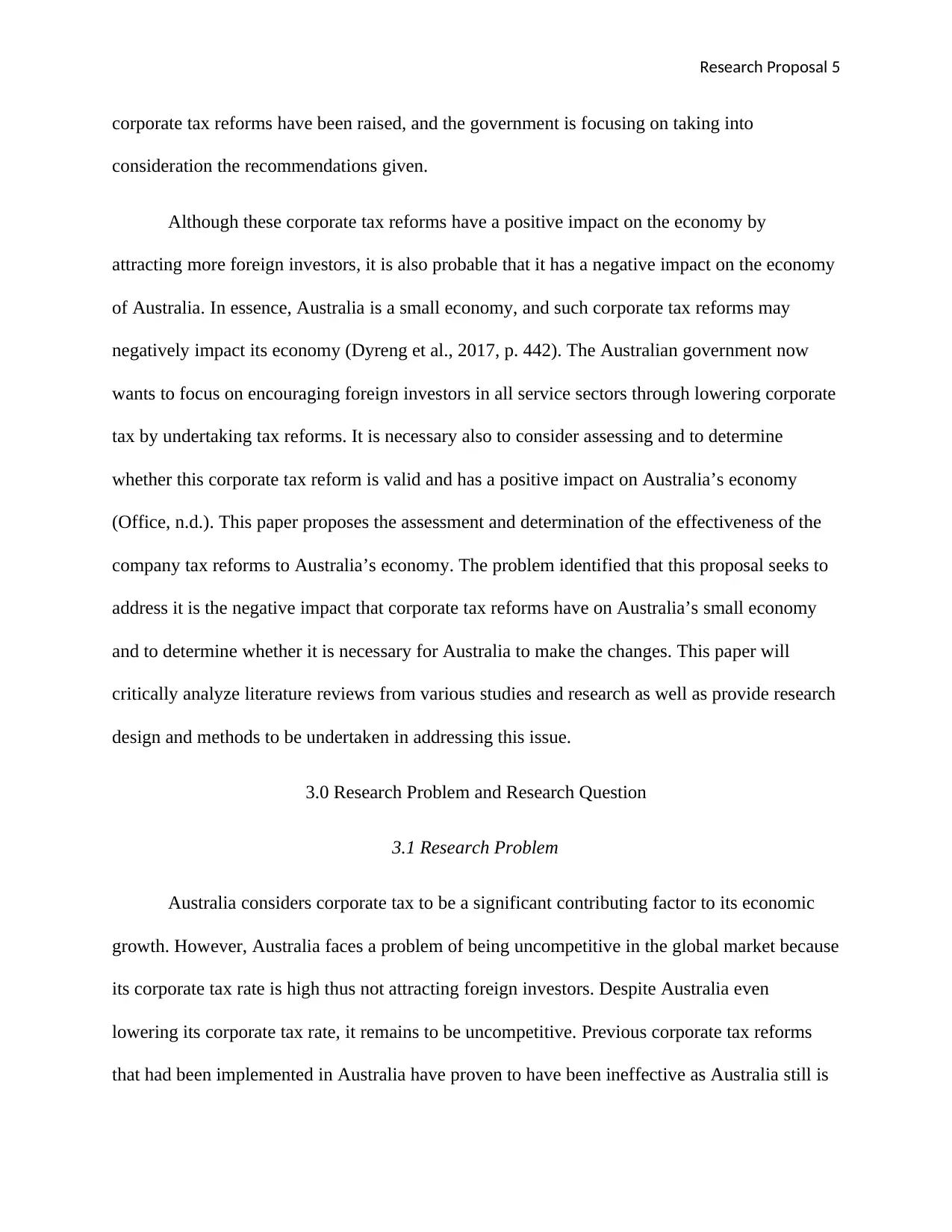
Research Proposal 5
corporate tax reforms have been raised, and the government is focusing on taking into
consideration the recommendations given.
Although these corporate tax reforms have a positive impact on the economy by
attracting more foreign investors, it is also probable that it has a negative impact on the economy
of Australia. In essence, Australia is a small economy, and such corporate tax reforms may
negatively impact its economy (Dyreng et al., 2017, p. 442). The Australian government now
wants to focus on encouraging foreign investors in all service sectors through lowering corporate
tax by undertaking tax reforms. It is necessary also to consider assessing and to determine
whether this corporate tax reform is valid and has a positive impact on Australia’s economy
(Office, n.d.). This paper proposes the assessment and determination of the effectiveness of the
company tax reforms to Australia’s economy. The problem identified that this proposal seeks to
address it is the negative impact that corporate tax reforms have on Australia’s small economy
and to determine whether it is necessary for Australia to make the changes. This paper will
critically analyze literature reviews from various studies and research as well as provide research
design and methods to be undertaken in addressing this issue.
3.0 Research Problem and Research Question
3.1 Research Problem
Australia considers corporate tax to be a significant contributing factor to its economic
growth. However, Australia faces a problem of being uncompetitive in the global market because
its corporate tax rate is high thus not attracting foreign investors. Despite Australia even
lowering its corporate tax rate, it remains to be uncompetitive. Previous corporate tax reforms
that had been implemented in Australia have proven to have been ineffective as Australia still is
corporate tax reforms have been raised, and the government is focusing on taking into
consideration the recommendations given.
Although these corporate tax reforms have a positive impact on the economy by
attracting more foreign investors, it is also probable that it has a negative impact on the economy
of Australia. In essence, Australia is a small economy, and such corporate tax reforms may
negatively impact its economy (Dyreng et al., 2017, p. 442). The Australian government now
wants to focus on encouraging foreign investors in all service sectors through lowering corporate
tax by undertaking tax reforms. It is necessary also to consider assessing and to determine
whether this corporate tax reform is valid and has a positive impact on Australia’s economy
(Office, n.d.). This paper proposes the assessment and determination of the effectiveness of the
company tax reforms to Australia’s economy. The problem identified that this proposal seeks to
address it is the negative impact that corporate tax reforms have on Australia’s small economy
and to determine whether it is necessary for Australia to make the changes. This paper will
critically analyze literature reviews from various studies and research as well as provide research
design and methods to be undertaken in addressing this issue.
3.0 Research Problem and Research Question
3.1 Research Problem
Australia considers corporate tax to be a significant contributing factor to its economic
growth. However, Australia faces a problem of being uncompetitive in the global market because
its corporate tax rate is high thus not attracting foreign investors. Despite Australia even
lowering its corporate tax rate, it remains to be uncompetitive. Previous corporate tax reforms
that had been implemented in Australia have proven to have been ineffective as Australia still is
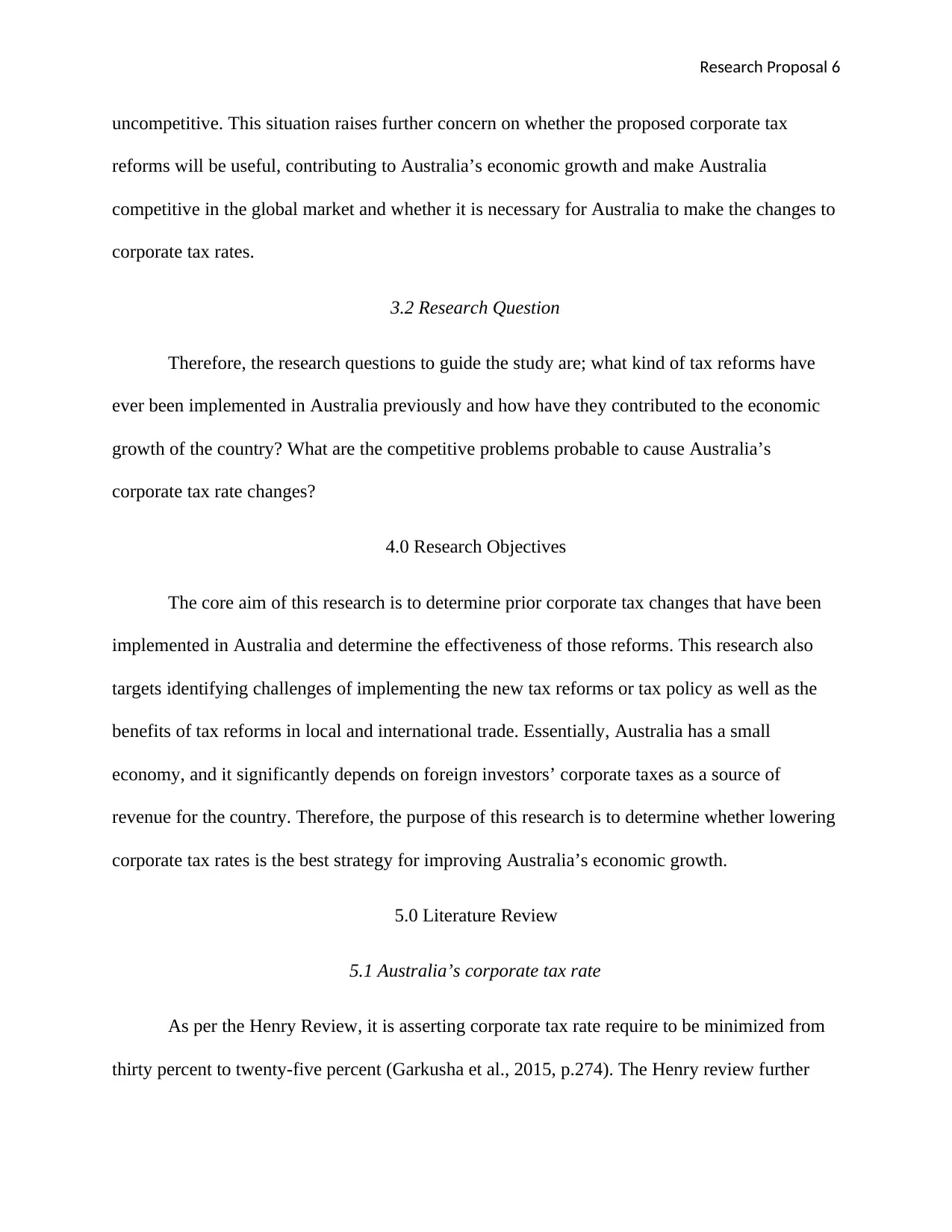
Research Proposal 6
uncompetitive. This situation raises further concern on whether the proposed corporate tax
reforms will be useful, contributing to Australia’s economic growth and make Australia
competitive in the global market and whether it is necessary for Australia to make the changes to
corporate tax rates.
3.2 Research Question
Therefore, the research questions to guide the study are; what kind of tax reforms have
ever been implemented in Australia previously and how have they contributed to the economic
growth of the country? What are the competitive problems probable to cause Australia’s
corporate tax rate changes?
4.0 Research Objectives
The core aim of this research is to determine prior corporate tax changes that have been
implemented in Australia and determine the effectiveness of those reforms. This research also
targets identifying challenges of implementing the new tax reforms or tax policy as well as the
benefits of tax reforms in local and international trade. Essentially, Australia has a small
economy, and it significantly depends on foreign investors’ corporate taxes as a source of
revenue for the country. Therefore, the purpose of this research is to determine whether lowering
corporate tax rates is the best strategy for improving Australia’s economic growth.
5.0 Literature Review
5.1 Australia’s corporate tax rate
As per the Henry Review, it is asserting corporate tax rate require to be minimized from
thirty percent to twenty-five percent (Garkusha et al., 2015, p.274). The Henry review further
uncompetitive. This situation raises further concern on whether the proposed corporate tax
reforms will be useful, contributing to Australia’s economic growth and make Australia
competitive in the global market and whether it is necessary for Australia to make the changes to
corporate tax rates.
3.2 Research Question
Therefore, the research questions to guide the study are; what kind of tax reforms have
ever been implemented in Australia previously and how have they contributed to the economic
growth of the country? What are the competitive problems probable to cause Australia’s
corporate tax rate changes?
4.0 Research Objectives
The core aim of this research is to determine prior corporate tax changes that have been
implemented in Australia and determine the effectiveness of those reforms. This research also
targets identifying challenges of implementing the new tax reforms or tax policy as well as the
benefits of tax reforms in local and international trade. Essentially, Australia has a small
economy, and it significantly depends on foreign investors’ corporate taxes as a source of
revenue for the country. Therefore, the purpose of this research is to determine whether lowering
corporate tax rates is the best strategy for improving Australia’s economic growth.
5.0 Literature Review
5.1 Australia’s corporate tax rate
As per the Henry Review, it is asserting corporate tax rate require to be minimized from
thirty percent to twenty-five percent (Garkusha et al., 2015, p.274). The Henry review further
⊘ This is a preview!⊘
Do you want full access?
Subscribe today to unlock all pages.

Trusted by 1+ million students worldwide
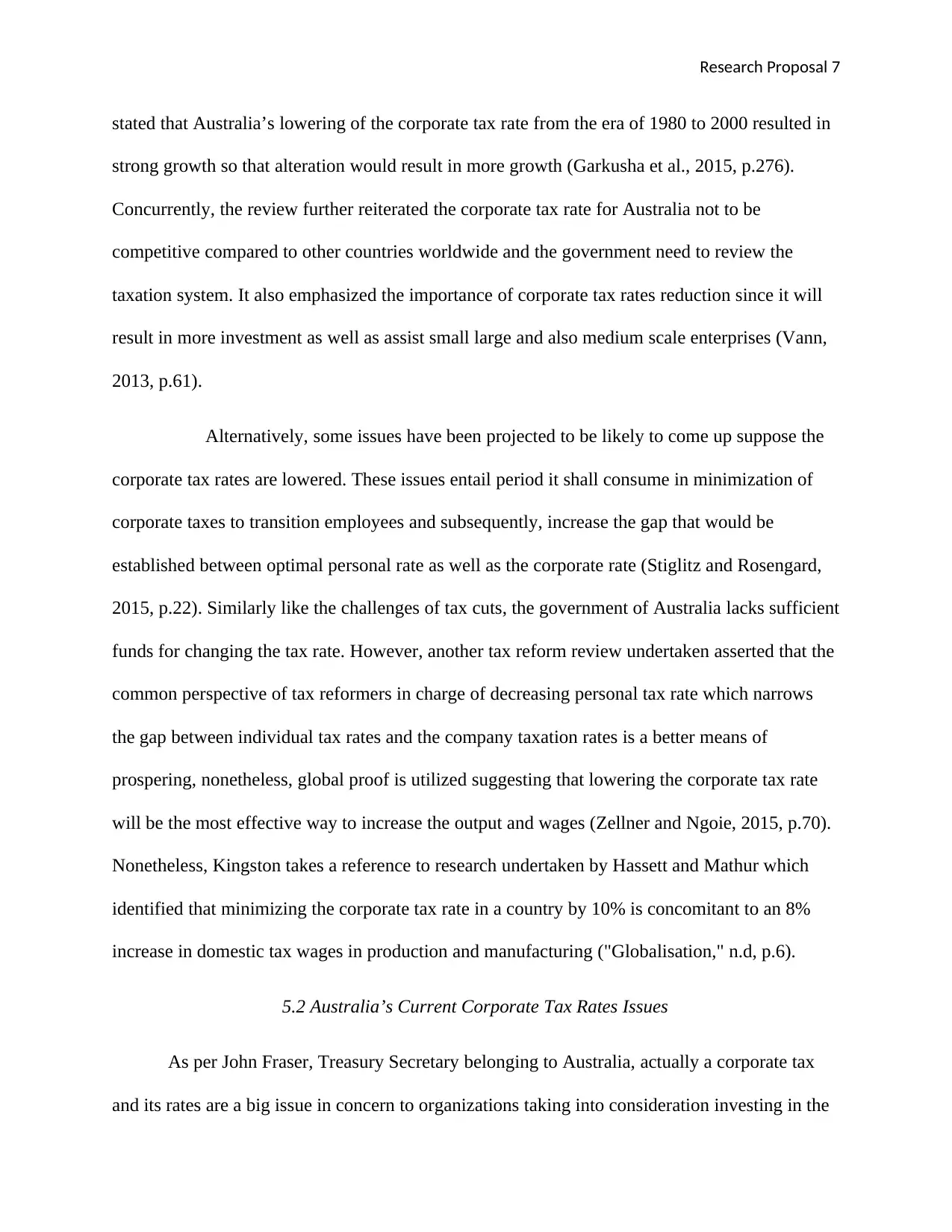
Research Proposal 7
stated that Australia’s lowering of the corporate tax rate from the era of 1980 to 2000 resulted in
strong growth so that alteration would result in more growth (Garkusha et al., 2015, p.276).
Concurrently, the review further reiterated the corporate tax rate for Australia not to be
competitive compared to other countries worldwide and the government need to review the
taxation system. It also emphasized the importance of corporate tax rates reduction since it will
result in more investment as well as assist small large and also medium scale enterprises (Vann,
2013, p.61).
Alternatively, some issues have been projected to be likely to come up suppose the
corporate tax rates are lowered. These issues entail period it shall consume in minimization of
corporate taxes to transition employees and subsequently, increase the gap that would be
established between optimal personal rate as well as the corporate rate (Stiglitz and Rosengard,
2015, p.22). Similarly like the challenges of tax cuts, the government of Australia lacks sufficient
funds for changing the tax rate. However, another tax reform review undertaken asserted that the
common perspective of tax reformers in charge of decreasing personal tax rate which narrows
the gap between individual tax rates and the company taxation rates is a better means of
prospering, nonetheless, global proof is utilized suggesting that lowering the corporate tax rate
will be the most effective way to increase the output and wages (Zellner and Ngoie, 2015, p.70).
Nonetheless, Kingston takes a reference to research undertaken by Hassett and Mathur which
identified that minimizing the corporate tax rate in a country by 10% is concomitant to an 8%
increase in domestic tax wages in production and manufacturing ("Globalisation," n.d, p.6).
5.2 Australia’s Current Corporate Tax Rates Issues
As per John Fraser, Treasury Secretary belonging to Australia, actually a corporate tax
and its rates are a big issue in concern to organizations taking into consideration investing in the
stated that Australia’s lowering of the corporate tax rate from the era of 1980 to 2000 resulted in
strong growth so that alteration would result in more growth (Garkusha et al., 2015, p.276).
Concurrently, the review further reiterated the corporate tax rate for Australia not to be
competitive compared to other countries worldwide and the government need to review the
taxation system. It also emphasized the importance of corporate tax rates reduction since it will
result in more investment as well as assist small large and also medium scale enterprises (Vann,
2013, p.61).
Alternatively, some issues have been projected to be likely to come up suppose the
corporate tax rates are lowered. These issues entail period it shall consume in minimization of
corporate taxes to transition employees and subsequently, increase the gap that would be
established between optimal personal rate as well as the corporate rate (Stiglitz and Rosengard,
2015, p.22). Similarly like the challenges of tax cuts, the government of Australia lacks sufficient
funds for changing the tax rate. However, another tax reform review undertaken asserted that the
common perspective of tax reformers in charge of decreasing personal tax rate which narrows
the gap between individual tax rates and the company taxation rates is a better means of
prospering, nonetheless, global proof is utilized suggesting that lowering the corporate tax rate
will be the most effective way to increase the output and wages (Zellner and Ngoie, 2015, p.70).
Nonetheless, Kingston takes a reference to research undertaken by Hassett and Mathur which
identified that minimizing the corporate tax rate in a country by 10% is concomitant to an 8%
increase in domestic tax wages in production and manufacturing ("Globalisation," n.d, p.6).
5.2 Australia’s Current Corporate Tax Rates Issues
As per John Fraser, Treasury Secretary belonging to Australia, actually a corporate tax
and its rates are a big issue in concern to organizations taking into consideration investing in the
Paraphrase This Document
Need a fresh take? Get an instant paraphrase of this document with our AI Paraphraser

Research Proposal 8
basis of his experience as an investment manager previously. Moreover, he emphasized that it
lacks essentiality if the rate of corporate tax stands are thirty percent or even thirty-five percent
since there are more vital concerns like governance as well as solving of disputes (Kawano and
Slemrod, 2016, p. 410). Nonetheless, alternatively, he is in support of the reduction of the
corporate tax rates with the aim of helping small as well as medium-sized companies. In the
2015 budget which proposed cutting of corporate tax rates by 1.5% for small enterprises, thus
reducing the corporate tax rate in that business segment to 28.5% (Bonoli, 2017, p. 25).
Additionally, a corporate tax rate decrease improves the flow of cash of the associated small
enterprises and as a result, increasing their potential of engaging within the economy.
In March 2015, the government of Australia released a tax discussion paper discussing
changes in corporate tax rates and other taxes in Australia. According to this tax discussion
paper, it asserts that the high corporate tax in Australia may discourage investment and
consequentially resulting in low wages and prosperity (HOW & VERHOEVEN, 2017, P.271).
Moreover, it confers that the present corporate tax rate is not competitive thus making it harder
for Australia to achieve its objectives of attracting necessary investment (“Part 1: Overview,”
n.d.). Additionally, the high corporate tax rate is capable of providing an incentive to companies
to facilitate profit shifting.
Furthermore, the tax discussion paper of 2015 portrays the reality of the way Australia
depends heavily on corporate tax income in comparison to other nations (Bamiatzi et al., 2016,
1450). For instance, the corporate taxation of Australia was 5.2% of the Gross Domestic Product,
while the counties were averaging at 2.9% of the Gross Domestic Product (Grubert and
Altshuler, 2015, p.32). Additionally, the reduction of the corporate tax rate for Australia will
draw higher investments as well as a result in capital deepening. However, this would eventually
basis of his experience as an investment manager previously. Moreover, he emphasized that it
lacks essentiality if the rate of corporate tax stands are thirty percent or even thirty-five percent
since there are more vital concerns like governance as well as solving of disputes (Kawano and
Slemrod, 2016, p. 410). Nonetheless, alternatively, he is in support of the reduction of the
corporate tax rates with the aim of helping small as well as medium-sized companies. In the
2015 budget which proposed cutting of corporate tax rates by 1.5% for small enterprises, thus
reducing the corporate tax rate in that business segment to 28.5% (Bonoli, 2017, p. 25).
Additionally, a corporate tax rate decrease improves the flow of cash of the associated small
enterprises and as a result, increasing their potential of engaging within the economy.
In March 2015, the government of Australia released a tax discussion paper discussing
changes in corporate tax rates and other taxes in Australia. According to this tax discussion
paper, it asserts that the high corporate tax in Australia may discourage investment and
consequentially resulting in low wages and prosperity (HOW & VERHOEVEN, 2017, P.271).
Moreover, it confers that the present corporate tax rate is not competitive thus making it harder
for Australia to achieve its objectives of attracting necessary investment (“Part 1: Overview,”
n.d.). Additionally, the high corporate tax rate is capable of providing an incentive to companies
to facilitate profit shifting.
Furthermore, the tax discussion paper of 2015 portrays the reality of the way Australia
depends heavily on corporate tax income in comparison to other nations (Bamiatzi et al., 2016,
1450). For instance, the corporate taxation of Australia was 5.2% of the Gross Domestic Product,
while the counties were averaging at 2.9% of the Gross Domestic Product (Grubert and
Altshuler, 2015, p.32). Additionally, the reduction of the corporate tax rate for Australia will
draw higher investments as well as a result in capital deepening. However, this would eventually

Research Proposal 9
be a promotion of growth in employment opportunities, productivity, wages as well as
innovation.
Also, the tax discussion paper of 2015 points out the effect of corporate tax rates on
economic development as well as living standards (Graham et al., 2017, p.3130). One major
reason discouraging foreign Australia’s investors is because it has a higher corporate rate in
which is even uncompetitive. This issue means that investment decisions investment decisions
may be impacted by the tax (Brys et al., 2011, p.34). In general, high taxes leads to fewer
investments. Just as economies tend to be more open, obstacles to investment may have a more
significant effect on the country’s economic development as well as the real wages growth.
5.3 Significance of Lowering Corporate Tax Rates
Through the reduction of corporate tax rates, this may boost top level investments. In
short-term, minimal tax rates are likely to attract foreign investors into Australia, and eventually,
all Australians will benefit from the increased investments (Pattenden and Twite, 2008, p.12).
Also, the low corporate tax rate in multinational firms would minimize the incentives in tax
planning as well as profit shift in Australia (Swank, 2016, p.575). The funds used on tax
planning will be saved as well as ultimately resulting in high revenues and also may be utilized
in a more productive way to the country’s economy.
Nonetheless, reducing the corporate tax rate will ultimately have a big effect on tax
revenues within a short period. Such loss is partly offset in long term investments because of low
tax rate generating more revenue (Arena and Kutner, 2015, p.2261). The present and available
investors will also be the benefit of the reduced corporate taxes and also new investors. Also, the
risks of experiencing base erosion and profit sharing are alleviating. The corporate tax rate for
be a promotion of growth in employment opportunities, productivity, wages as well as
innovation.
Also, the tax discussion paper of 2015 points out the effect of corporate tax rates on
economic development as well as living standards (Graham et al., 2017, p.3130). One major
reason discouraging foreign Australia’s investors is because it has a higher corporate rate in
which is even uncompetitive. This issue means that investment decisions investment decisions
may be impacted by the tax (Brys et al., 2011, p.34). In general, high taxes leads to fewer
investments. Just as economies tend to be more open, obstacles to investment may have a more
significant effect on the country’s economic development as well as the real wages growth.
5.3 Significance of Lowering Corporate Tax Rates
Through the reduction of corporate tax rates, this may boost top level investments. In
short-term, minimal tax rates are likely to attract foreign investors into Australia, and eventually,
all Australians will benefit from the increased investments (Pattenden and Twite, 2008, p.12).
Also, the low corporate tax rate in multinational firms would minimize the incentives in tax
planning as well as profit shift in Australia (Swank, 2016, p.575). The funds used on tax
planning will be saved as well as ultimately resulting in high revenues and also may be utilized
in a more productive way to the country’s economy.
Nonetheless, reducing the corporate tax rate will ultimately have a big effect on tax
revenues within a short period. Such loss is partly offset in long term investments because of low
tax rate generating more revenue (Arena and Kutner, 2015, p.2261). The present and available
investors will also be the benefit of the reduced corporate taxes and also new investors. Also, the
risks of experiencing base erosion and profit sharing are alleviating. The corporate tax rate for
⊘ This is a preview!⊘
Do you want full access?
Subscribe today to unlock all pages.

Trusted by 1+ million students worldwide

Research Proposal 10
Australia is very uncompetitive (Mahar, 2016, p. 142). This uncompetitiveness discourages
foreign investors from getting into Australia to invest thus impacting the economic growth of the
country.
Moreover, a higher corporate tax rate provides an incentive that causes profit shifting
(Clausing, 2016, p. 4). Suppose the corporate tax rates are reduced it will avoid companies from
profit shifting as well as attracting necessary investment. Nonetheless, it would result in revenue
losses for a short period.
Tax cutting can slow down the economic growth through an increase in budget deficits
(McClure et al., 2018, p.501). Whenever the economy is functioning close to prospective
governmental borrowing funded through diversion of some capital which would have been
channeled into private investment or rather through borrowing from investors. However,
government borrowing outdoes private investment, thus minimizing future productivity
comparative to what it would look like or lowers the amount of income that would be obtained in
future from the investment of the citizens of the country (Spence, 2016, 489). However, deficits
reduce the wellbeing of future generations. The long term impacts of tax policies rely not only on
the incentive impact but also on the budget impacts. Suppose the government lessens marginal
tax rates for personal incomes, for instance, long-term effects that can be positive or negative
relying on the effects of savings as well as investments outweighing the likely drag from
alleviated deficits (McClure et al., 2018, p. 499).
5.4 Competitive Declination of Tax Rates
Many countries have utilized the recent tax reforms in lowering taxes on enterprises as
well as individuals, with an aim of improving on the investment, consumption as well as the
Australia is very uncompetitive (Mahar, 2016, p. 142). This uncompetitiveness discourages
foreign investors from getting into Australia to invest thus impacting the economic growth of the
country.
Moreover, a higher corporate tax rate provides an incentive that causes profit shifting
(Clausing, 2016, p. 4). Suppose the corporate tax rates are reduced it will avoid companies from
profit shifting as well as attracting necessary investment. Nonetheless, it would result in revenue
losses for a short period.
Tax cutting can slow down the economic growth through an increase in budget deficits
(McClure et al., 2018, p.501). Whenever the economy is functioning close to prospective
governmental borrowing funded through diversion of some capital which would have been
channeled into private investment or rather through borrowing from investors. However,
government borrowing outdoes private investment, thus minimizing future productivity
comparative to what it would look like or lowers the amount of income that would be obtained in
future from the investment of the citizens of the country (Spence, 2016, 489). However, deficits
reduce the wellbeing of future generations. The long term impacts of tax policies rely not only on
the incentive impact but also on the budget impacts. Suppose the government lessens marginal
tax rates for personal incomes, for instance, long-term effects that can be positive or negative
relying on the effects of savings as well as investments outweighing the likely drag from
alleviated deficits (McClure et al., 2018, p. 499).
5.4 Competitive Declination of Tax Rates
Many countries have utilized the recent tax reforms in lowering taxes on enterprises as
well as individuals, with an aim of improving on the investment, consumption as well as the
Paraphrase This Document
Need a fresh take? Get an instant paraphrase of this document with our AI Paraphraser

Research Proposal 11
labor market contribution progressing a trend which began several years ago, as per the new
report of the OECD (Richardson et al., 2015, p.47). Essentially, tax policy reforms of 2018
elaborate the resent tax reforms in thirty-five Tax Policy Reforms of 2018 describing the resent
tax reforms being undertaken in thirty-five OECD member countries (Cannavan et al., 2017,
p.12). The report determines the main tax policy trends and points out the economic stimuli
offered by the fiscal policy inclusive of a more substantial portion of tax policy thus becoming
more vital.
Substantial tax reforms initiatives have been proposed to Australia among other countries
strongly focusing on encouraging investment as well as some intervening measure made to
promote fairness. Some countries have started tax measures outstandingly and formally (Chalk et
al., 2018, p.9). In all countries, this report indicates the progressive trend in corporate income tax
rate reduction and has been significantly driven by significant reforms in many big countries
with traditional high corporate taxes. The mean corporate tax rates in the OECD member
countries depreciated from 32.6 percent in 2000 to 23.9 percent in 2018 (Atkinson et al., 2011,
p.22). Even with the depreciating trend in the mean corporate tax rates which has gotten a
transformed momentum in current years, corporate tax rate cuts are slightly mentioned earlier
before the emergence of the crisis.
Essentially, among the countries which have incorporated substantial corporate tax
reforms are those with higher corporate tax rates, whereby tax reforms were past due. However,
these corporate tax reductions have raised some concerns regarding the race towards the bottom
whereby most of such countries seem to be engaging in their race to the average economic
performance with their current corporate tax rate reduction now putting them in the centre of the
labor market contribution progressing a trend which began several years ago, as per the new
report of the OECD (Richardson et al., 2015, p.47). Essentially, tax policy reforms of 2018
elaborate the resent tax reforms in thirty-five Tax Policy Reforms of 2018 describing the resent
tax reforms being undertaken in thirty-five OECD member countries (Cannavan et al., 2017,
p.12). The report determines the main tax policy trends and points out the economic stimuli
offered by the fiscal policy inclusive of a more substantial portion of tax policy thus becoming
more vital.
Substantial tax reforms initiatives have been proposed to Australia among other countries
strongly focusing on encouraging investment as well as some intervening measure made to
promote fairness. Some countries have started tax measures outstandingly and formally (Chalk et
al., 2018, p.9). In all countries, this report indicates the progressive trend in corporate income tax
rate reduction and has been significantly driven by significant reforms in many big countries
with traditional high corporate taxes. The mean corporate tax rates in the OECD member
countries depreciated from 32.6 percent in 2000 to 23.9 percent in 2018 (Atkinson et al., 2011,
p.22). Even with the depreciating trend in the mean corporate tax rates which has gotten a
transformed momentum in current years, corporate tax rate cuts are slightly mentioned earlier
before the emergence of the crisis.
Essentially, among the countries which have incorporated substantial corporate tax
reforms are those with higher corporate tax rates, whereby tax reforms were past due. However,
these corporate tax reductions have raised some concerns regarding the race towards the bottom
whereby most of such countries seem to be engaging in their race to the average economic
performance with their current corporate tax rate reduction now putting them in the centre of the

Research Proposal 12
pack (Henty et al., 2017, p.11). However, it is anticipated that other countries will respond to
such trends better in future.
5.5 International Corporate Tax Changes
OECD identifies more than just corporate tax reform, several common tax reform
trends in their current report. Individual income tax reductions have been implemented in various
countries, mainly to improve the tax burden on low as well as the middle-income earners (Chalk
et al., 2018, p.11). The most common approach is to ensure increased income tax credits in
earnings that can attain dual objectives of alleviating labor market partaking as well as improving
the progressiveness of the tax system. Also, more reforms regarding security precisely social
security contribution, in general, have been constrained, and such charges will progress to burden
the labor income in several countries. The Value-added (VAT) tax rates became stable as South
Africa remained to be the only country whereby the standard VAT rate was increased in 2018
(Chalk et al., 2018, p.13). Higher VAT rates have made several countries to seek alternative
means to raise additional VAT revenues, particularly using tax administration as well as anti-
fraud interventions.
Substantially, till today, the depreciating statutory corporate tax rates have not at the
moment minimized company tax assortments as the Gross Domestic Product share. This is due
to the deteriorating statutory corporate tax rates usually are conveyed by tax base increment, and
also corporate sector enlargement as well as increased profitability over the applicable time
(McClure et al., 2018, p. 500). As global tax antagonism probably caused the declination of the
statutory company tax rates, alternatively, policymakers or even electorates might have
incorporated what seems to be a prosperous policy adopted by other nations. Domestic
deliberations might also have been germane (McClure et al., 2018, p. 501). For Australia, the
pack (Henty et al., 2017, p.11). However, it is anticipated that other countries will respond to
such trends better in future.
5.5 International Corporate Tax Changes
OECD identifies more than just corporate tax reform, several common tax reform
trends in their current report. Individual income tax reductions have been implemented in various
countries, mainly to improve the tax burden on low as well as the middle-income earners (Chalk
et al., 2018, p.11). The most common approach is to ensure increased income tax credits in
earnings that can attain dual objectives of alleviating labor market partaking as well as improving
the progressiveness of the tax system. Also, more reforms regarding security precisely social
security contribution, in general, have been constrained, and such charges will progress to burden
the labor income in several countries. The Value-added (VAT) tax rates became stable as South
Africa remained to be the only country whereby the standard VAT rate was increased in 2018
(Chalk et al., 2018, p.13). Higher VAT rates have made several countries to seek alternative
means to raise additional VAT revenues, particularly using tax administration as well as anti-
fraud interventions.
Substantially, till today, the depreciating statutory corporate tax rates have not at the
moment minimized company tax assortments as the Gross Domestic Product share. This is due
to the deteriorating statutory corporate tax rates usually are conveyed by tax base increment, and
also corporate sector enlargement as well as increased profitability over the applicable time
(McClure et al., 2018, p. 500). As global tax antagonism probably caused the declination of the
statutory company tax rates, alternatively, policymakers or even electorates might have
incorporated what seems to be a prosperous policy adopted by other nations. Domestic
deliberations might also have been germane (McClure et al., 2018, p. 501). For Australia, the
⊘ This is a preview!⊘
Do you want full access?
Subscribe today to unlock all pages.

Trusted by 1+ million students worldwide
1 out of 27
Related Documents
Your All-in-One AI-Powered Toolkit for Academic Success.
+13062052269
info@desklib.com
Available 24*7 on WhatsApp / Email
![[object Object]](/_next/static/media/star-bottom.7253800d.svg)
Unlock your academic potential
Copyright © 2020–2025 A2Z Services. All Rights Reserved. Developed and managed by ZUCOL.




